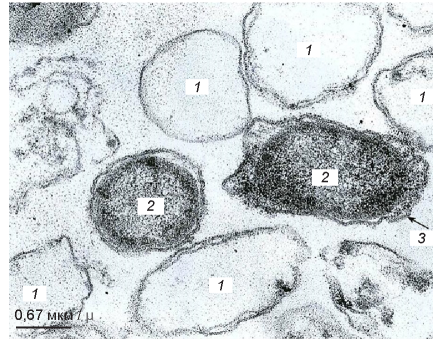Vol 97, No 1 (2020)
- Year: 2020
- Published: 02.04.2020
- Articles: 14
- URL: https://microbiol.crie.ru/jour/issue/view/27
- DOI: https://doi.org/10.36233/0372-9311-2020-97-1
Full Issue
ORIGINAL RESEARCHES
Obtaining and Characterization of the Monoclonal Antibodies Against G-Protein of the Respiratory Syncytial Virus
Abstract
The aim of this study was to obtain hybridomas producing monoclonal antibodies (Mabs) to the G-protein of the respiratory syncytial virus (RSV), and to evaluate their immunological characteristics and virus-neutralizing activity.
Material and methods. Mouse Mabs were obtained using hybridoma technology. The properties of Mabs were studied by enzyme-linked immunosorbent assay (ELISA), immunofluorescence staining (IF) of infected cells, as well as by biological neutralization test in vitro (NT). To identify epitopes recognized by the Mabs on G protein ELISA additivity test was used.
Results. Hybridization of splenocytes with Sp2/0 myeloma cells and primary screening showed that 75 hybridomas produce antibodies interacting with purified virus, 17 of them also react with the recombinant G-protein in ELISA. In NT 4, hybridomas suppressed in vitro RSV infection by more than 50%. Cloning of these hybridomas revealed 4 monoclones producing the most active Mabs. Mab 1C11 was IgG2a, 3 others (5D4, 5G11 and 6H4) were IgM. Three IgM Mabs actively reacted with both RSV A2 and Long, and with G-protein; Mab 1C11 was less reactive with all antigens tested. All Mabs suppressed RSV infection, while Mab 5D4 supressed it almost completely (98%). IF analysis showed that all Mabs detected RSV G-protein in the cell cytoplasm, the largest number of infected cells was detected using Mab 5D4 (80%). It was shown that the isolated Mabs were directed to two non-overlapping epitopes on the RSV G-protein.
Conclusion. The isolated Mabs can be used to detect RSV in clinical samples by ELISA and IF. The isolated Mabs can be used for humanized recombinant antibodies construction and for the treatment of RSV infection in future.
 7-14
7-14


Model of Prophylactic Efficiency of Influenza Virus Vaccine Corrected to the Antigenic Distance Hypothesis
Abstract
The aim of the study is to find a quantitative relationship between antigenic distances (AD) and vaccination effectiveness (VE) and investigate the response of VE to changes in AD.
Material and methods. Through the epidemiological data of three influenza seasons in Canada, interpreted within the framework of the antigenic distance hypothesis (ADH), the introduction of the correction factor into the model for estimating VE was substantiated considering the antigenic relationship between the previous season vaccine (V1), the current season vaccine (V2) and the circulating epidemic strain (e).
Results. A quantitative relationship between VE and AD was found, reproducing the results of epidemiological observation of two groups of people: vaccinated in the previous and current seasons (V1+V2) and vaccinated only in the current season (0+V2). The difference in the response of VE to different indicators of AD was found and allowing to use only one significant indicator.
Conclusion. Тhe model proposed relates the microbiological indicators AD with epidemiological characteristic of VE. The model extends the analysis, allowing to use it as an assessment tool for the expected changes in vaccine effectiveness in various settings of the ADH hypothesis experiment.
 15-18
15-18


The Microbiota Continuum along the Reproductive Tract in Women with Infertility
Abstract
Introduction. At present, the question of commensal, including opportunistic, microflora participation in infertility development remains debatable. In a number of studies, the translocation of the vaginal microflora into the endometrial tissue is considered as a factor contributing to inflammation development. In addition, the connection of some reproductive losses with the persistence of certain conditionally pathogenic microorganisms is shown. Today, to solve this issue, molecular genetic research methods are being actively introduced that surpass the routine cultivation techniques in a number of positions.
The aim of the study was to assess the taxonomic diversity of microorganisms in the vaginal biotope with infertility.
Material and methods. For the study samples of vaginal contents obtained from the posterior vaginal fornix of 15 women, consisting of barren marriage, were used. A metagenomic study of 16S ribosomal RNA samples was carried out on the Illumina MiSeq platform, using the MiSeq Reagent Kits v3 kit (600-Cycle Kit), as recommended by the manufacturer. Libraries for sequencing plots of the V3-V4 gene of the 16S ribosomal RNA were prepared according to the 16S Metagenomic Sequencing Library Preparation Illumina. In bioinformatics assessment, Kraken Metagenomics version 2.0.0 software for metagenomic analysis (classifier of reads — short nucleotide sequences) was used using a standard database.
Results. It was shown that the occurrence of representatives of the Lactobacillaceae family in the vaginal biotope varies from 12 to 84%. The genus Lactobacillus with the dominance of L. jensenii, L. delbrueckii and L. amylolyticus occupied the leading position among the members of the family. In all samples, Moraxella spp. was found in large numbers, with M. osloensis leading among the representatives of the entire community. In half of the cases, the joint presence of M. osloensis and G. vaginalis was revealed.
Conclusion. It has been established that in infertility in the vaginal microbiota the number of representatives of the genus Lactobacillus is significantly reduced, and there is also a change in the leading species to L. jensenii, whose functional activity does not fully ensure the colonization resistance of the vaginal biotope, allowing for excessive reproduction of oppotrunistic microorganisms, in particular, M. osloensis.
 26-31
26-31


Current Epidemiological Features of Viral Hepatitis B and C, Tuberculosis and HIV Infection In Psychiatric Hospitals
Abstract
Background. Psychiatric hospitals, where patients with immunodeficiency often do not comply with basic preventive measures, as well as receiving a wide range of medical procedures, including parenteral ones, are the institutions of high risk of socially significant infections spreading.
The aim was to study the current epidemiological features of parenteral hepatitis among various categories of mentally ill patients (with pulmonary tuberculosis and HIV infection) and medical personnel in a large psychiatric hospital.
Materials and methods. Serological markers of hepatitis B (HB) and hepatitis C (HC) were determined in 8352 patients and 542 employees of a large psychiatric hospital using domestic diagnostic test systems.
Results. Markers of HB and HC among patients were revealed in 7.2% of persons (HB — 2.8%, HC — 3.1%, and HB+HC — 1.4%). The analysis of sex, age and social characteristics of HBVand HCV-patients was conducted. Markers of HC were significantly more common in HIV-infected patients (44.4% of individuals); the main routes of transmission of HB and HC were intravenous drug use and sexual intercourse. Among patients with pulmonary tuberculosis, the maximum number of persons was found with markers of HB (44.3%) and HB+HC (38.2%); the main clinical form of pulmonary tuberculosis was represented by the infiltrative form (60.4%); in 53,7% of cases the bacillary forms were identified that pose a serious epidemiological risk in the spread of tuberculosis in the hospital. Analysis of the social structure showed that HBV+HC+HIV and pulmonary tuberculosis are characteristics of persons with aggravated social status. The most frequent factors of infection with HBV and HCV were longterm parenteral loading and intravenous drug use. The greatest factor of parenteral load was observed in mentally ill patients diagnosed with HB+HC accompanying tuberculosis. It was shown that the frequency of HBV and HCV markers detection among medical personnel depends on the department profile, work duration, frequency and risk of contact with blood during professional activity.
Conclusion. A high level of comorbidity of mental disorders and socially significant infectious diseases (HIV infection, tuberculosis and HB and HC) has been established, which has a significant impact on the epidemic process of these infections. Preventive programmes established in hospitals and in the territories they serve should take into account their comorbidity. The necessity of specific and non-specific prevention of viral hepatitis in patients and medical staff of psychiatric hospitals is shown.
 32-39
32-39


Etiological and Epidemiological Characteristics of Lethality from Acute Viral Hepatitis, Kyrgyzstan, 2009−2018
Abstract
Purpose. Study of the etiological structure of lethality from acute viral hepatitis and its comparison with morbidity and mortality for the period of 2009−2018.
Materials and methods. State Reporting Forms No. 1 “Report on Infectious, Parasitic and Non-Infectious Diseases” for the period of 2009−2018 were studied. The data was processed by the Microsoft Office Excel statistical package.
Results. In Kyrgyzstan, during the period of 2009−2018, 138,612 cases of acute viral hepatitis (AVH) were detected, of which 109 patients had fatal outcomes. In the general structure of the latter, the proportions of patients with acute hepatitis B (AHB 36.7%) and A (AHA, 35.7%) were approximately the same. In every fifth case, “unverified acute viral hepatitis (UAVH)” was diagnosed (22.9%). Acute hepatitis C (AHC) was the cause of death in 4 patients (3%), and hepatitis D virus (HDV) infection in 1 patient. Among the deceased, there were no cases of hepatitis E. Lethality from AHB was recorded in 5 children, and from hepatitis C in one child. At the same time, 9 out of 25 patients with “Unverified Acute Viral Hepatitis” were children. Over the period of 2009−2018, the incidence of AHB was 31.3 times lower than that of all AVH in general (240.9 and 7.7⁰/0000, AVH and AHB, respectively), the mortality rate was 2.7 times lower (0.19 and 0.07⁰/0000, AVH and AHB, respectively), and the lethality rate was 11.4 times higher (7.9 and 89.8⁰/0000, AVH and AHB, respectively). The average incidence of AHB in children was 6.4 times lower (7.7 and 1.2⁰/0000, total and children, respectively), the mortality rate was 2.3 times lower (0.07 and 0.03⁰/0000, total and children, respectively), and the lethality rate was 1.8 times higher (89.8 and 165.9⁰/0000, total and children, respectively).
Conclusion. The existence of morbidity and lethality in adults and children from acute hepatitis indicates a high disease burden for the country. The high proportion of AHB and AHA in the structure of AVH mortality requires improving the quality of immunization of children and expanding the coverage of adults with vaccination against these viral hepatitis. The increase in lethality against the background of a tenfold decrease in the incidence of AVH points out that the number of patients who have died from this pathology does not decrease.
 40-46
40-46


Spatial Visualization of Data on the Antibiotic Resistance of Vibrio cholerae Strains Isolated in Russia
Abstract
Aim. The aim was to develop an integrated online and updated geographic information system (GIS) for the systematiza tion and analysis of information on V. cholerae El Tor antibiotic resistance.
Material and methods. The method of serial dilutions in a dense nutrient medium (MUK 4.2.2495-09) was used to determine the sensitivity/resistance to 22 antibacterial preparations of V. cholerae O1 El Tor strains isolated from people and from aquatic environmental objects in Russia in 2005–2016. The development of the Internet version of the GIS was carried out using programming languages HTML, JavaScript and PHP and cartographic data obtained from the corporation Rostelecom (Russia) and the community OpenStreetMap.
Results. A comparative analysis of the antibiotic resistance of the strains by regions of the Russian Federation and by isolation time showed an increase of strains resistant to streptomycin, ampicillin, rifampicin and furazolidone, the appearance of cultures resistant to nalidixic acid and ceftriaxone, reduced resistance to trimethoprim/sulfamethoxazole in 2012–2016 compared to 2005–2009. In the Stavropol Krai, the isolated V. cholerae O1 El Tor were characterized by resistance to furazolidone (33.3%) and trimethoprim/sulfamethoxazole (100%); in the Primorsky Krai — to ampicillin, streptomycin, rifampicin (7%), furazolidone (43%), trimethoprim/sulfamethoxazole (100%); in the Irkutsk region and Kalmykia, to ampicillin (8.3% and 11%), furazolidone and trimethoprim/sulfamethoxazole (11% and 89%).
Conclusion. The GIS developed allows to collect and analyze information on the antibiotic resistance of V. cholerae O1 El Tor, and to select the strains for given properties.
 47-54
47-54


About the Results of Monitoring Researches of Ballast Waters and Data of Identification of the Vibrioes Strains Selected During the Ships Researches in Russian Seaports in 2018
Abstract
Relevance. In September, 2017 the International Convention on Control of Ships’ Ballast Waters and sediments, in which the Russian Federation takes part, came into effect.
Aim of article is to cover the results of implementation of the Convention in Russia, regarding selection and analysis of ballast waters tests for compliance with the international standard.
Material and methods. The materials for work were data on ship arrivals at the international seaports of the Russian Federation, provided by sanitary and quarantine departments of the Russian ports, and monitoring researches of ballast waters in seaports of some regions of the Russian Federation. Analytical, bacteriological, molecular methods were applied.
Results. The studies of ballast waters in the Leningrad and Kaliningrad regions have been conducted for the first time in 2018, and in the Rostov region the study lasts since 2010. The laboratory researches of ships’ ballast showed that E. coli, Enterococcus spp. were in norm, V. cholerae O1 and O139 in ballast were absent. 12 of 21 ballast water tests investigated by specialists of the Rostov region laboratories contained V. cholerae non-O1/non-O139, ballast was taken on the ships which arrived from Romania and Turkey.
Сonclusion. The results of the molecular and genetic researches suggest that there is a probability of V. сholeraе introduction brougth with ship ballast. Management decisions are demanded to ensure biological safety of shipping and to decrease intestinal infections incidence in residents of the seaside cities.
 55-61
55-61


Effect of Rabbit Immunization with Yeast Antigens on the Activity of the Fraction of Serum Antimicrobial Peptides
Abstract
The aim was to study the effect of rabbit immunization with different yeasts cells on overall antimicrobial serum activity and specific activity of antimicrobial peptides fraction.
Material and methods. Rabbits were immunized with cells of Candida albicans, Rhodotorula mucilaginosa, Malassezia furfur, Cryptococcus neoformans, Geotrichum candidum, Trichosporon cutaneum and Saccharomyces cerevisiae. AMP fractions were obtained by filtration through 100 kDa filters. Overall activities of sera and their AMP-fractions were estimated spectrophotometrically.
Results. Overall serum antimicrobial activity had tendency to decrease after immunization independently from yeast species. Activity of AMP-fractions after immunization with C. albicans, Cr. neoformans, G. candi dum и S. ce revisiae increased, but with other yeasts — decreased. The highest sensitivity to AMP fraction cor res ponded to C. albicans, especially for serum of the rabbit immunized with this yeasts — 1,5-fold higher com pare to control. Serum albumin concentration showed the positive correlation with overall antimicrobial activity against C. albicans (r = 0,760), R. mucilaginosa (r = 0,728), M. furfur (r = 0,723) и T. cutaneum (r = 0,588).
Discussion. The results confirm our earlier data. Moreover, they expand current views on the effect of yeasts antigens on activity of serum AMP against different yeasts.
Conclusion. Serum albumin and serum AMP demonstrated the specificity toward different yeasts: maximal activity they showed towards specia which more often play opportunistic role.
 19-25
19-25


REVIEWS
Heteromorphism of Persistence of Sapronosis Causative Agents in Cells in Various Environmental Conditions
Abstract
The paper discusses the issues of morphofunctional variability of sapronoses pathogens in stressful environment. In the current century, sapronoses infections attract increasing attention. Under unfavorable environmental conditions the pathogens use the strategy for the formation of resting (stable) states, that is: viable but non-culturable cell formes and persistent bacteria, which are characterized by reduced metabolism and changes in the morphology and physiology of the microorganisms, termination of replication. Possibility of sapronoses pathogens survival in interepidemic period and antibiotic resistance formation, which play an important role in chronic infections, are associated with the formation of persistent forms of bacteria. The literature extensively discusses mechanisms and conditions of the pathogenic bacteria stable states formation and their pathogenetic contribution to infectious pathology, whereas ultrastructural organization and morphological variability of persistent cell forms, as well as their differentiation, causing the pathogens population heterogeneity, is still insufficiently illuminated. Based on the analysis of current data and their own experience, the authors evaluate the morphological and functional changes of bacteria stable cellular forms and their role in sapronoses pathogens adaptation strategies.
 62-71
62-71


Immunological and Epidemiological Aspects of the Immunogenicity of Streptococcus Pneumoniae Serotype 3 Capsular Polysaccharide in Pneumococcal Vaccines
Abstract
The introduction of pneumococcal vaccines into national immunization programmes around the world has reduced the incidence of pneumococcal vaccine serotypes, but had no influence on the incidence of Streptococcus pneumoniae serotype 3 included in their composition. The results of evaluation of epidemiological efficacy and immunogenicity of capsular polysaccharide of S. pneumoniae serotype 3 capsular polysaccharide (CP) in conjugated and polysaccharide pneumococcal vaccines are contradictory. Some studies have shown the effectiveness of vaccination, other studies indicate insufficient immunogenicity and prophylactic efficacy of S. pneumoniae serotype 3 CP. The authors’ analysis of the results of clinical studies showed that the prophylactic efficacy of S. pneumoniae serotype 3 CP depends on the type of vaccine, nosological form of the disease, age, immunization schedule. According to the literature data, the most informative parameter of the protective activity of S. pneumoniae CP in pneumococcal vaccines, including serotype 3, is opsonophagocytosis. The experimental data of the low immunogenicity of serotype 3 CP, presumably associated with an unusual way of synthesis of its CP, are considered. To increase the im muno genicity of S. pneumoniae serotype 3 CP, the use of synthetic oligosaccharides of a strictly defined chemical structure corresponding to the protective fragments of serotype 3 CP and conjugated with a carrier protein for induction of T-dependent immune response and immunological memory is promising.
 72-82
72-82


Modern Conceptions about the Mechanisms of Interaction Between Biofilm and Cellular Immunity Factors
Abstract
Features of the cellular immune response in the presence of a microbial biofilm are well described in the literature. Based on numerous studies, it became possible to establish a number of patterns: mature biofilms are better protected from immune factors, the effectiveness of antibiofilm strategies depends on species of the microorganisms, forming the biofilm, and, accordingly, on the composition of the biopolymer matrix. For example, rhamnolipids and alginate of Pseudomonas aeruginosa exert a significant negative effect on the function of immunocompetent cells. The bacteria of biofilms became able to turn to their advantage many of the protective reactions developed by the immune system and fixed evolutionarily, applying them for the growth and development of the microbial consortium.
 83-90
83-90


HISTORY OF SCIENCE
Theory of Sapronous Infections: the History of Development and Ways of Improvement in the System of Medical and Biological Sciences
Abstract
The article represents the history of studies of human diseases caused by faсultative parasites of humans, animals and plants, attributed by microbiologist V.I. Terskych in 1958 to the third class of infections named sapronoses. The concept of sapronous pathogens ecology is one of priorities of Russian medicine. Since that time, facts and generalizations have been accumulated in the world and national science, allowing to revise the initial concept of sapronous infections of biota — from prokaryotes, plants and invertebrates to warm-blooded animals and humans. To decide the controversial issues of the sapronoses theory, epidemiological terminology and systematics of infectious pathology, it is necessary to integrate the knowledge and systemic participation of specialists in medicine and biology in studying this problem. The results of this cooperation will make it possible to clarify and form a unified theoretical concept of the population pathology of the biota based on the ecological approach and general biological regularities of life existence in the world.
 91-101
91-101


CHRONICLE
 102-103
102-103


 104-105
104-105
















